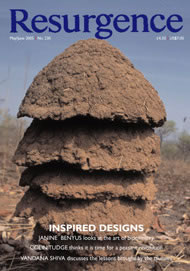"NATURE IS THE greatest teacher," said my mother: "even greater than the Buddha."
"How could anything be a greater teacher than the Buddha?" I asked. I was only eight years old then, but I remember the conversation vividly.
After a brief pause, mother replied, "The Buddha may have been the greatest among human teachers, but he received his enlightenment while sitting under a tree. In that moment of being at one with nature, he realised the interdependence of all existence and how life is designed in such an intricate and symbiotic manner that millions of forms live with each other in a harmonious and miraculous way. No-one manages nature; nature needs no rulers, yet the laws of the universe and the health of the Earth are maintained. The Buddha learned all that whilst observing nature. So the tree was his true teacher." These words were spoken to me by my mother in 1944.
Now we have a woman of similar wisdom. She is a scientist, a writer and a visionary. She is Janine Benyus. We are delighted to be publishing her insights about learning from nature. Most, if not all, universities concentrate on learning about nature. Now learning about nature appears to have a very destructive goal. Scientists learn about nature in order to control it, whereas learning from nature has an ecological humility, and such humility has a spiritual quality.
But spirituality seems to be a suspect word. People associate it with religion, superstition and dogma. The 'S' word has become corrupted! We need to reclaim the word and rescue it from misinterpretation. Matter is what can be measured. Spirit is beyond measure. Matter is about quantity, and spirit is about quality. Matter is about outer form or substance, spirit is about inner meaning. We need matter and we need spirit. One without the other is useless. The role of religion is to enhance our sense of the spirit.
In this issue we present design and architecture that have a spiritual underpinning. Our authors give a religious and ecological perspective on buildings and gardens. They explain how Christian, Buddhist and Islamic values have informed our sense of design in the past, and should do so in the future. Yes, we should design as nature designs, and we should do so with humility, reverence and restraint. Thus natural architecture and human architecture will be complementary. Nature and culture will enhance each other. Matter and spirit form the whole. This is design with a difference; design with frugality.
James Hillman said, "The environmental crisis is a crisis of aesthetics." In my view aesthetics falls into the sphere of the spirit. Sustainability requires an aesthetic which is spiritual and ecological. Only such an aesthetic can bring balance, harmony, health and happiness. So let us return to nature and spirit.








